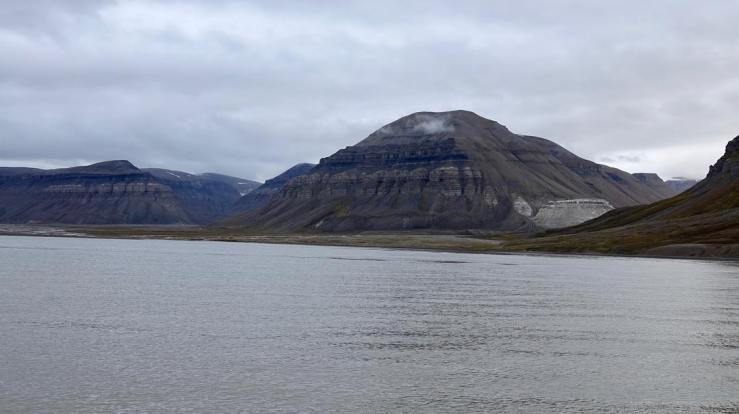Day 3, 19/07/2018, Ymerbukta (78°16’N/13°59’E) – Skansbukta (78°31’N/16°05’E)
Stamattina siamo partiti di fretta dal ghiacciaio Esmarkbreen per dirigerci verso Pyramiden, dove avremmo dovuto passare la notte. Sfortuna vuole che le previsioni del tempo non fossero corrette (per niente) e invece di mare calmo e poco vento, abbiamo avuto onde alte e vento forte (fino a 8Bft su una scala di 12). Per lo sforzo di sopravvivere a questa tempesta senza stare male ci siamo tutti addormentati cullati, o scaraventati di qua e di là dal letto, per tutta la durata del viaggio. Invece di tirare dritto fino a Pyramiden, ci siamo fermati al fiordo precedente, chiamato Skansbukta, dove Charles era sicuro che avremmo trovato un posto sicuro per passare la notte, e così è stato. Siamo andati a dormire, forzandoci, verso la 1:30 di mattina visto che non diventa mai scuro. Abbiamo dormito come bambini.

This morning we left the Esmarkbreen Glatscher in a rush heading to Pyramiden, where we were going to stay overnight. Bad luck: the weather forecast was wrong (really wrong) and instead of a calm sea with no wind, we encountered big waves and strong winds (up to 8Bft on a scale of 12). Managing to stand in such a stormy weather was exhausting, therefore we all slept during the entire trip. Instead of going straight to Pyramiden, we stopped to a closer fjord, called Skansbukta, where Charles felt sure we’d find a safe place to stay overnight. And he was right. We went to sleep at 1:30 a.m. forcing ourselves due to the 24 hours day light that makes it difficult to feel sleepy, on top of the fact that we spent a day sleeping, therefore we were not tired. Eventually we managed to sleep like logs.
Day 4, 20/07/2018, Skansbukta (78°31’N/16°05’E) – Nordenskiöldbreen (78°38’N/16°54’E)
Il Nordenskiöldbreen è un ghiacciaio che si trova di fronte alla città russa di Pyramiden. Ci siamo recati alle relative coordinate per pranzare con una vista mozzafiato su questo magnifico ghiacciaio.
Quando la barca si è fermata eravamo, chiaramente, nel mare e non nel ghiaccio ma se fossimo stati nello stesso punto oggi tre anni fa, saremmo stati dentro al ghiacciaio. Il Nordenskiöldbreen si è ritirato di 1 km tra il 1990 e il 2002 e sta continuando a ritirarsi. Questo processo succede esattamente allo stesso modo anche in Svizzera, anche se nell’Artico è più freddo e più a Sud meno. I ghiacciai che si ritirano possono creare gravi danni nel nostro paese come per esempio agli edifici ma anche a intere vallate. Per quanto riguarda il ritiro dei ghiacciai nell’Artico, apparentemente dell’acqua che cade nel mare non ha un grande impatto ma indirettamente, sulle isole che stanno affogando in mezzo ai tropici, sì.Gli umani non sono responsabili per la potenza dell’Artico. Vedere questi immensi ghiacciai, la grandezza delle onde e il sentimento di forza dell’acqua – semplicemente rimaniamo in silenzio e realizziamo quanto piccoli siamo. Ironicamente, abbiamo la capacità di cambiare l’acidità degli oceani, di scaldare l’atmosfera e di sciogliere i ghiacciai. Un gioco di forza tra gli umani e la natura. È ora di approfondire la nostra relazione con la natura. È ora di trovare pace in mezzo a questa tempesta che sono i cambiamenti climatici. Qual è la tua relazione e la tua esperienza con la natura?
Non sapresti dire? Ovunque tu sia, vai a fare una lunga passeggiata nel bosco, in montagna o fai un tuffo in acqua, cosa senti? La natura è tua amica o tua nemica?” -Joëlle Perreten

The Nordenskiöldbreen is a glacier in front of the russian city Pyramiden. We went there for a lunch with a view. A great view.
When the boat came to a stop, we obviously were in the sea, however, had it been 3 years ago, that same spot would have been into the glacier.The Nordenskiöldbreen glacier melted and shrank 1 km between 1990 and 2002 and it still is. The same that happens Switzerland, happens even in this colder environment. Melting glaciers in Switzerland can damage buildings or entire valleys. Instead, in the Arctic, melting glaciers provoke a steep rise of the level of the sea; this does not directly impact the rest of the world, however it slowly but surely will make several islands disappear under water.
Humans are not in charge of the power of the Arctic. Seeing the immense glaciers, the size of the waves and feeling the power of the water – we just turn silent and realize how small we really are. Ironically, we are able to change the acidity of the ocean, to heat up the atmosphere, to melt glaciers. A power game between humans and nature. It’s time to deepen our relationship with this planet. To find peace within the storm of climate change and environmental challenges. What is your relation and experience with nature?

You don’t know? Wherever you are, just take a long walk in the forest, in the mountain or jump into the water, what do you feel? Is nature your friend or your enemy?” -Joëlle Perreten